Input interpretation

H_2O water + NaBr sodium bromide + O_3 ozone ⟶ O_2 oxygen + NaOH sodium hydroxide + Br_2 bromine
Balanced equation
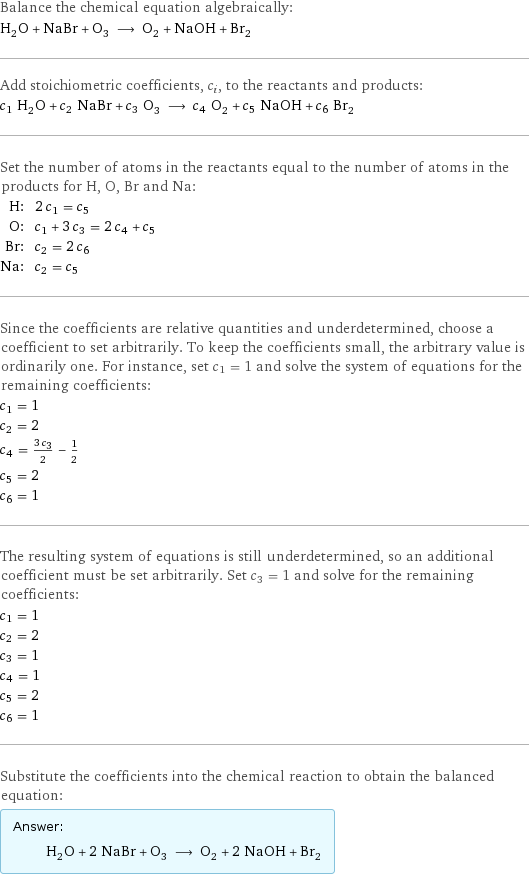
Balance the chemical equation algebraically: H_2O + NaBr + O_3 ⟶ O_2 + NaOH + Br_2 Add stoichiometric coefficients, c_i, to the reactants and products: c_1 H_2O + c_2 NaBr + c_3 O_3 ⟶ c_4 O_2 + c_5 NaOH + c_6 Br_2 Set the number of atoms in the reactants equal to the number of atoms in the products for H, O, Br and Na: H: | 2 c_1 = c_5 O: | c_1 + 3 c_3 = 2 c_4 + c_5 Br: | c_2 = 2 c_6 Na: | c_2 = c_5 Since the coefficients are relative quantities and underdetermined, choose a coefficient to set arbitrarily. To keep the coefficients small, the arbitrary value is ordinarily one. For instance, set c_1 = 1 and solve the system of equations for the remaining coefficients: c_1 = 1 c_2 = 2 c_4 = (3 c_3)/2 - 1/2 c_5 = 2 c_6 = 1 The resulting system of equations is still underdetermined, so an additional coefficient must be set arbitrarily. Set c_3 = 1 and solve for the remaining coefficients: c_1 = 1 c_2 = 2 c_3 = 1 c_4 = 1 c_5 = 2 c_6 = 1 Substitute the coefficients into the chemical reaction to obtain the balanced equation: Answer: | | H_2O + 2 NaBr + O_3 ⟶ O_2 + 2 NaOH + Br_2
Structures

+ + ⟶ + +
Names

water + sodium bromide + ozone ⟶ oxygen + sodium hydroxide + bromine
Reaction thermodynamics
Enthalpy
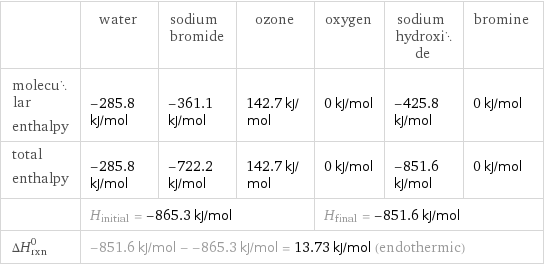
| water | sodium bromide | ozone | oxygen | sodium hydroxide | bromine molecular enthalpy | -285.8 kJ/mol | -361.1 kJ/mol | 142.7 kJ/mol | 0 kJ/mol | -425.8 kJ/mol | 0 kJ/mol total enthalpy | -285.8 kJ/mol | -722.2 kJ/mol | 142.7 kJ/mol | 0 kJ/mol | -851.6 kJ/mol | 0 kJ/mol | H_initial = -865.3 kJ/mol | | | H_final = -851.6 kJ/mol | | ΔH_rxn^0 | -851.6 kJ/mol - -865.3 kJ/mol = 13.73 kJ/mol (endothermic) | | | | |
Gibbs free energy
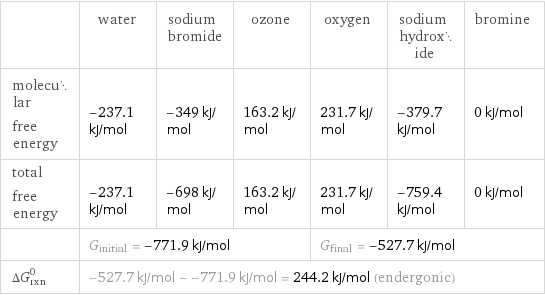
| water | sodium bromide | ozone | oxygen | sodium hydroxide | bromine molecular free energy | -237.1 kJ/mol | -349 kJ/mol | 163.2 kJ/mol | 231.7 kJ/mol | -379.7 kJ/mol | 0 kJ/mol total free energy | -237.1 kJ/mol | -698 kJ/mol | 163.2 kJ/mol | 231.7 kJ/mol | -759.4 kJ/mol | 0 kJ/mol | G_initial = -771.9 kJ/mol | | | G_final = -527.7 kJ/mol | | ΔG_rxn^0 | -527.7 kJ/mol - -771.9 kJ/mol = 244.2 kJ/mol (endergonic) | | | | |
Entropy
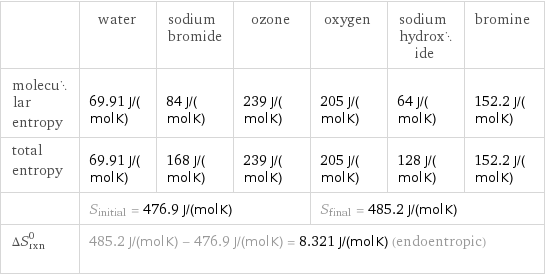
| water | sodium bromide | ozone | oxygen | sodium hydroxide | bromine molecular entropy | 69.91 J/(mol K) | 84 J/(mol K) | 239 J/(mol K) | 205 J/(mol K) | 64 J/(mol K) | 152.2 J/(mol K) total entropy | 69.91 J/(mol K) | 168 J/(mol K) | 239 J/(mol K) | 205 J/(mol K) | 128 J/(mol K) | 152.2 J/(mol K) | S_initial = 476.9 J/(mol K) | | | S_final = 485.2 J/(mol K) | | ΔS_rxn^0 | 485.2 J/(mol K) - 476.9 J/(mol K) = 8.321 J/(mol K) (endoentropic) | | | | |
Equilibrium constant
![Construct the equilibrium constant, K, expression for: H_2O + NaBr + O_3 ⟶ O_2 + NaOH + Br_2 Plan: • Balance the chemical equation. • Determine the stoichiometric numbers. • Assemble the activity expression for each chemical species. • Use the activity expressions to build the equilibrium constant expression. Write the balanced chemical equation: H_2O + 2 NaBr + O_3 ⟶ O_2 + 2 NaOH + Br_2 Assign stoichiometric numbers, ν_i, using the stoichiometric coefficients, c_i, from the balanced chemical equation in the following manner: ν_i = -c_i for reactants and ν_i = c_i for products: chemical species | c_i | ν_i H_2O | 1 | -1 NaBr | 2 | -2 O_3 | 1 | -1 O_2 | 1 | 1 NaOH | 2 | 2 Br_2 | 1 | 1 Assemble the activity expressions accounting for the state of matter and ν_i: chemical species | c_i | ν_i | activity expression H_2O | 1 | -1 | ([H2O])^(-1) NaBr | 2 | -2 | ([NaBr])^(-2) O_3 | 1 | -1 | ([O3])^(-1) O_2 | 1 | 1 | [O2] NaOH | 2 | 2 | ([NaOH])^2 Br_2 | 1 | 1 | [Br2] The equilibrium constant symbol in the concentration basis is: K_c Mulitply the activity expressions to arrive at the K_c expression: Answer: | | K_c = ([H2O])^(-1) ([NaBr])^(-2) ([O3])^(-1) [O2] ([NaOH])^2 [Br2] = ([O2] ([NaOH])^2 [Br2])/([H2O] ([NaBr])^2 [O3])](../image_source/ccafbd312352eed527a6991f3e1d4ddc.png)
Construct the equilibrium constant, K, expression for: H_2O + NaBr + O_3 ⟶ O_2 + NaOH + Br_2 Plan: • Balance the chemical equation. • Determine the stoichiometric numbers. • Assemble the activity expression for each chemical species. • Use the activity expressions to build the equilibrium constant expression. Write the balanced chemical equation: H_2O + 2 NaBr + O_3 ⟶ O_2 + 2 NaOH + Br_2 Assign stoichiometric numbers, ν_i, using the stoichiometric coefficients, c_i, from the balanced chemical equation in the following manner: ν_i = -c_i for reactants and ν_i = c_i for products: chemical species | c_i | ν_i H_2O | 1 | -1 NaBr | 2 | -2 O_3 | 1 | -1 O_2 | 1 | 1 NaOH | 2 | 2 Br_2 | 1 | 1 Assemble the activity expressions accounting for the state of matter and ν_i: chemical species | c_i | ν_i | activity expression H_2O | 1 | -1 | ([H2O])^(-1) NaBr | 2 | -2 | ([NaBr])^(-2) O_3 | 1 | -1 | ([O3])^(-1) O_2 | 1 | 1 | [O2] NaOH | 2 | 2 | ([NaOH])^2 Br_2 | 1 | 1 | [Br2] The equilibrium constant symbol in the concentration basis is: K_c Mulitply the activity expressions to arrive at the K_c expression: Answer: | | K_c = ([H2O])^(-1) ([NaBr])^(-2) ([O3])^(-1) [O2] ([NaOH])^2 [Br2] = ([O2] ([NaOH])^2 [Br2])/([H2O] ([NaBr])^2 [O3])
Rate of reaction
![Construct the rate of reaction expression for: H_2O + NaBr + O_3 ⟶ O_2 + NaOH + Br_2 Plan: • Balance the chemical equation. • Determine the stoichiometric numbers. • Assemble the rate term for each chemical species. • Write the rate of reaction expression. Write the balanced chemical equation: H_2O + 2 NaBr + O_3 ⟶ O_2 + 2 NaOH + Br_2 Assign stoichiometric numbers, ν_i, using the stoichiometric coefficients, c_i, from the balanced chemical equation in the following manner: ν_i = -c_i for reactants and ν_i = c_i for products: chemical species | c_i | ν_i H_2O | 1 | -1 NaBr | 2 | -2 O_3 | 1 | -1 O_2 | 1 | 1 NaOH | 2 | 2 Br_2 | 1 | 1 The rate term for each chemical species, B_i, is 1/ν_i(Δ[B_i])/(Δt) where [B_i] is the amount concentration and t is time: chemical species | c_i | ν_i | rate term H_2O | 1 | -1 | -(Δ[H2O])/(Δt) NaBr | 2 | -2 | -1/2 (Δ[NaBr])/(Δt) O_3 | 1 | -1 | -(Δ[O3])/(Δt) O_2 | 1 | 1 | (Δ[O2])/(Δt) NaOH | 2 | 2 | 1/2 (Δ[NaOH])/(Δt) Br_2 | 1 | 1 | (Δ[Br2])/(Δt) (for infinitesimal rate of change, replace Δ with d) Set the rate terms equal to each other to arrive at the rate expression: Answer: | | rate = -(Δ[H2O])/(Δt) = -1/2 (Δ[NaBr])/(Δt) = -(Δ[O3])/(Δt) = (Δ[O2])/(Δt) = 1/2 (Δ[NaOH])/(Δt) = (Δ[Br2])/(Δt) (assuming constant volume and no accumulation of intermediates or side products)](../image_source/b6b91c06b90513ec51d519784e3c9869.png)
Construct the rate of reaction expression for: H_2O + NaBr + O_3 ⟶ O_2 + NaOH + Br_2 Plan: • Balance the chemical equation. • Determine the stoichiometric numbers. • Assemble the rate term for each chemical species. • Write the rate of reaction expression. Write the balanced chemical equation: H_2O + 2 NaBr + O_3 ⟶ O_2 + 2 NaOH + Br_2 Assign stoichiometric numbers, ν_i, using the stoichiometric coefficients, c_i, from the balanced chemical equation in the following manner: ν_i = -c_i for reactants and ν_i = c_i for products: chemical species | c_i | ν_i H_2O | 1 | -1 NaBr | 2 | -2 O_3 | 1 | -1 O_2 | 1 | 1 NaOH | 2 | 2 Br_2 | 1 | 1 The rate term for each chemical species, B_i, is 1/ν_i(Δ[B_i])/(Δt) where [B_i] is the amount concentration and t is time: chemical species | c_i | ν_i | rate term H_2O | 1 | -1 | -(Δ[H2O])/(Δt) NaBr | 2 | -2 | -1/2 (Δ[NaBr])/(Δt) O_3 | 1 | -1 | -(Δ[O3])/(Δt) O_2 | 1 | 1 | (Δ[O2])/(Δt) NaOH | 2 | 2 | 1/2 (Δ[NaOH])/(Δt) Br_2 | 1 | 1 | (Δ[Br2])/(Δt) (for infinitesimal rate of change, replace Δ with d) Set the rate terms equal to each other to arrive at the rate expression: Answer: | | rate = -(Δ[H2O])/(Δt) = -1/2 (Δ[NaBr])/(Δt) = -(Δ[O3])/(Δt) = (Δ[O2])/(Δt) = 1/2 (Δ[NaOH])/(Δt) = (Δ[Br2])/(Δt) (assuming constant volume and no accumulation of intermediates or side products)
Chemical names and formulas
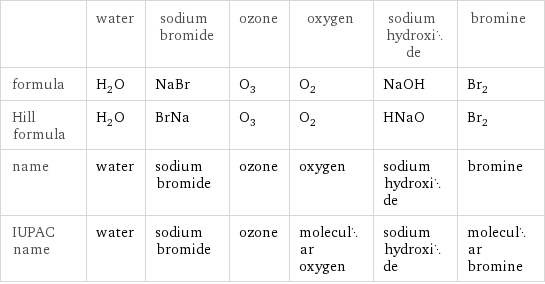
| water | sodium bromide | ozone | oxygen | sodium hydroxide | bromine formula | H_2O | NaBr | O_3 | O_2 | NaOH | Br_2 Hill formula | H_2O | BrNa | O_3 | O_2 | HNaO | Br_2 name | water | sodium bromide | ozone | oxygen | sodium hydroxide | bromine IUPAC name | water | sodium bromide | ozone | molecular oxygen | sodium hydroxide | molecular bromine
Substance properties
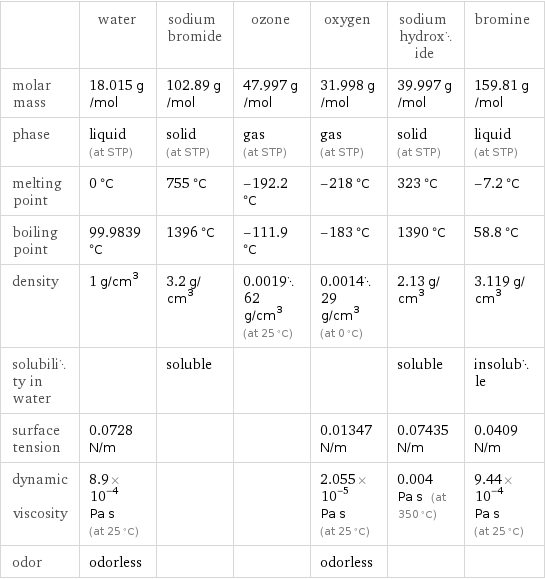
| water | sodium bromide | ozone | oxygen | sodium hydroxide | bromine molar mass | 18.015 g/mol | 102.89 g/mol | 47.997 g/mol | 31.998 g/mol | 39.997 g/mol | 159.81 g/mol phase | liquid (at STP) | solid (at STP) | gas (at STP) | gas (at STP) | solid (at STP) | liquid (at STP) melting point | 0 °C | 755 °C | -192.2 °C | -218 °C | 323 °C | -7.2 °C boiling point | 99.9839 °C | 1396 °C | -111.9 °C | -183 °C | 1390 °C | 58.8 °C density | 1 g/cm^3 | 3.2 g/cm^3 | 0.001962 g/cm^3 (at 25 °C) | 0.001429 g/cm^3 (at 0 °C) | 2.13 g/cm^3 | 3.119 g/cm^3 solubility in water | | soluble | | | soluble | insoluble surface tension | 0.0728 N/m | | | 0.01347 N/m | 0.07435 N/m | 0.0409 N/m dynamic viscosity | 8.9×10^-4 Pa s (at 25 °C) | | | 2.055×10^-5 Pa s (at 25 °C) | 0.004 Pa s (at 350 °C) | 9.44×10^-4 Pa s (at 25 °C) odor | odorless | | | odorless | |
Units
